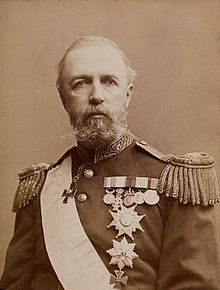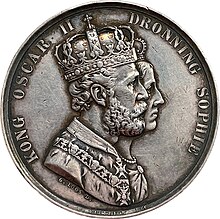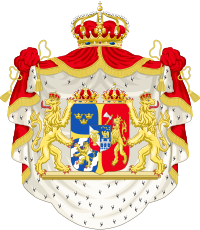Oscar II
| Oscar II | |
|---|---|
Riddarholm Church | |
| Spouse |
Lutheran |
| Signature | |
Oscar II (Oscar Fredrik;
Oscar was the son of
Oscar II is the paternal great-great-grandfather of
Early life
Oscar Fredrik was born in
Prince Oscar entered the Royal Swedish Navy as a midshipman at the age of eleven, and was appointed junior lieutenant in July 1845. Later he studied at Uppsala University, where he distinguished himself in mathematics.[3] On 13 December 1848, was made an honorary member of the Royal Swedish Academy of Sciences.
A distinguished writer and musical amateur himself, King Oscar proved a generous friend of learning, and did much to encourage the development of education throughout his dominions. In 1858 a collection of his lyrical and narrative poems, Memorials of the Swedish Fleet, published anonymously, obtained the second prize of the Swedish Academy. His "Contributions to the Military History of Sweden in the Years 1711, 1712, 1713", originally appeared in the Annals of the academy, and were printed separately in 1865. His works, which included his speeches, translations of Herder's Cid and Goethe's Torquato Tasso, and a play, Castle Cronberg, were collected in two volumes in 1875–76, and a larger edition, in three volumes, appeared in 1885–88.[3]
In 1859, Prince Oscar became
King of Sweden and Norway

Oscar II became King on 18 September 1872, upon the death of his brother,
Foreign and domestic statecraft

His acute intelligence and his aloofness from the dynastic considerations affecting most European sovereigns (both his paternal and maternal grandfathers were French military commanders who served under
In 1897 he was empowered to appoint a fifth arbitrator if necessary in the Venezuelan dispute, and he was called on to act as umpire in the Anglo-American arbitration treaty that was quashed by the United States Senate. He won many friends in the United Kingdom by his outspoken and generous support of Britain at the time of the Second Boer War (1899–1902), expressed in a declaration printed in The Times of 2 May 1900, when continental opinion was almost universally hostile.[3]
He remained a strong supporter of the Navy throughout his life, and frequently visited ships of the fleet. When the coastal defence ship Oscar II was launched, he even signed his name on the vessel's aft main gun tower.[4]
The office of Prime Minister of Sweden was instituted in 1876. Louis De Geer became the first head of government in Sweden to use this title. The most known and powerful first minister of the Crown during the reign of Oscar was the conservative estate owner Erik Gustaf Boström. Boström served as Prime Minister in 1891–1900 and 1902–1905. He was trusted and respected by Oscar II, who had much difficulty approving someone else as prime minister. Over a period of time, the King gave Boström a free hand to select his own ministers without much royal involvement. It was an arrangement (unintentional by both the King and Boström) that furthered the road to parliamentarism.
Science and the arts

His Easter hymn and some other of his poems are familiar throughout the Scandinavian countries. His work on Charles XII of Sweden were translated into English in 1879. In 1881 he founded the world's first open-air museum, at Bygdøy, located next to his summer residence near Oslo (back then known as Christiania). In 1885 he published his Address to the Academy of Music, and a translation of one of his essays on music appeared in Literature in May 1900. He had a valuable collection of printed and manuscript music, which was readily accessible to the historical student of music.[3]
Being a theater lover, he commissioned a new opera house to be built by Axel Anderberg for the Royal Swedish Opera which was inaugurated on 19 September 1898. It remains as the home of that institution. Oscar II once told playwright Henrik Ibsen that his Ghosts was "not a good play". As he was dying, he requested that the theatres not be closed on account of his death. His wishes were respected.
Oscar was also particularly interested in mathematics. In 1889 he set up a contest, on the occasion of his 60th birthday, for "an important discovery in the realm of higher mathematical analysis".[5][6] The contest listed four potential areas of research, one of which was the n-body problem in celestial mechanics, relevant to the stability of the solar system. Henri Poincare, a professor at the University of Paris, won by submitting an entry showing that even the 3-body problem was unstable, the seminal result in what is now called chaos theory.[7][8]
King Oscar II was an enthusiast of Arctic exploration. Along with Swedish millionaire
Oscar was also a generous sponsor of the sciences and personally funded the Vega Expedition, which was the first Arctic expedition to navigate through the Northeast Passage, the sea route between Europe and Asia through the Arctic Ocean, and the first voyage to circumnavigate Eurasia.
Death
The political events which led up to the peaceful
Marriage and children


Engraving by Anders Zorn.
On 6 June 1857 he married in
- King Gustaf V(1858–1950)
- Prince Oscar, Duke of Gotland, later known as Prince Oscar Bernadotte, Count of Wisborg(1859–1953)
- Prince Carl, Duke of Västergötland (1861–1951)
- Prince Eugen, Duke of Närke (1865–1947)
His eldest son Gustaf was Duke of
Alleged extramarital children
Oscar II is also suspected to have had several extramarital children,[11] of which at least five are named:
- Anna Hofman-Uddgren (1868–1947) by Emma Hammarström (1849–1910)[12]
- Elin Esping Smitz (1878–1960) by Paulina Mathilda Esping (1858–1878)[13][14]
- Knut August Ekstam (born 1878, in U.S.A. 1903, death unknown) by Marie Friberg (1852–1934)
- Florence Stephens (1881–1979) by Elisabeth Kreüger Stephens (1858–1911)[15]
- Nils Teodor Ekstam (1889–1954) also by Friberg above[16][17]
However, unlike his father, Oscar II never officially recognized any illegitimate children of his.
Honours

- National[18]
- Knight and Commander of the Seraphim, 21 January 1829
- Knight of the Order of Charles XIII, 21 January 1829
- Commander Grand Cross of the Sword, 21 January 1829
- Commander Grand Cross of the Polar Star, 21 January 1829
- Commander Grand Cross of the Order of Vasa, 15 June 1866[19]
- Grand Cross of St. Olav, with Collar, 21 August 1847[20]
- Founder and Master of the Order of the Norwegian Lion, 21 January 1904 – 26 October 1905[21]
- Foreign[18]
 Anhalt: Grand Cross of the Order of Albert the Bear
Anhalt: Grand Cross of the Order of Albert the Bear Royal Hungarian Order of St. Stephen, 1866[22]
Royal Hungarian Order of St. Stephen, 1866[22] Baden:[23]
Baden:[23]
- Knight of the House Order of Fidelity, 1877
- Knight of the Order of Berthold the First, 1877
 Knight of St. Hubert, 1862[24]
Knight of St. Hubert, 1862[24] Belgium: Grand Cordon of the Order of Leopold, 17 May 1856[25]
Belgium: Grand Cordon of the Order of Leopold, 17 May 1856[25] Brazil: Grand Cross of the Southern Cross
Brazil: Grand Cross of the Southern Cross Denmark:[26]
Denmark:[26]
- Knight of the Elephant, 3 June 1848
- Cross of Honour of the Order of the Dannebrog, 5 October 1863
 France:
France:
- Honour medal for Courage and Devotion, 23 March 1862[27]
- Grand Cross of the Legion of Honour
- Gold Médaille militaire
 Greece: Grand Cross of the Redeemer
Greece: Grand Cross of the Redeemer Hanover: Grand Cross of the Royal Guelphic Order, 1852[28]
Hanover: Grand Cross of the Royal Guelphic Order, 1852[28] Order of Kamehameha I
Order of Kamehameha I Hesse-Darmstadt: Grand Cross of the Ludwig Order, 20 September 1881[29]
Hesse-Darmstadt: Grand Cross of the Ludwig Order, 20 September 1881[29] Italy: Knight of the Annunciation, 10 January 1862[30]
Italy: Knight of the Annunciation, 10 January 1862[30] Japan: Grand Cordon of the Order of the Chrysanthemum, 27 July 1881[31]
Japan: Grand Cordon of the Order of the Chrysanthemum, 27 July 1881[31] Mecklenburg: Grand Cross of the Wendish Crown, with Crown in Ore
Mecklenburg: Grand Cross of the Wendish Crown, with Crown in Ore Grand Cross of St. Charles, 16 January 1862[32]
Grand Cross of St. Charles, 16 January 1862[32] Nassau: Knight of the Gold Lion of Nassau, July 1858[33]
Nassau: Knight of the Gold Lion of Nassau, July 1858[33] Netherlands: Grand Cross of the Netherlands Lion
Netherlands: Grand Cross of the Netherlands Lion Luxembourg: Grand Cross of the Oak Crown
Luxembourg: Grand Cross of the Oak Crown Ottoman Empire:
Ottoman Empire:
- Order of Osmanieh, 1st Class
- Order of Distinction
 Beylik of Tunis: Husainid Family Order
Beylik of Tunis: Husainid Family Order Portugal:
Portugal:
- Grand Cross of the Tower and Sword
- Grand Cross of the Sash of the Three Orders
 Persia: House Order of the Imperial Effigy, 1st Class
Persia: House Order of the Imperial Effigy, 1st Class Prussia:
Prussia:
- Knight of the Black Eagle, 28 September 1861;[34] with Collar
- Grand Cross of the Red Eagle
- Grand Commander's Cross of the Royal House Order of Hohenzollern, 12 June 1875[34]
 Romania:
Romania:
 Russia:
Russia:
- Knight of St. Andrew, 9 July 1846
- Knight of St. Alexander Nevsky
- Knight of the White Eagle
- Knight of St. Anna, 1st Class
- Knight of St. Stanislaus, 1st Class
 Saxony: Knight of the Rue Crown, 1875[35]
Saxony: Knight of the Rue Crown, 1875[35] Saxe-Weimar-Eisenach: Grand Cross of the White Falcon, 26 May 1862[36]
Saxe-Weimar-Eisenach: Grand Cross of the White Falcon, 26 May 1862[36] Serbia: Grand Cross of the Cross of Takovo
Serbia: Grand Cross of the Cross of Takovo- Siam:
- Knight of the Order of the Royal House of Chakri, 29 October 1888
- Grand Cross of the White Elephant
 Spain: Knight of the Golden Fleece, 14 July 1872[37]
Spain: Knight of the Golden Fleece, 14 July 1872[37] United Kingdom: Stranger Knight Companion of the Garter, 17 May 1881[38]
United Kingdom: Stranger Knight Companion of the Garter, 17 May 1881[38] Venezuela: Collar of the Order of the Liberator
Venezuela: Collar of the Order of the Liberator Württemberg: Grand Cross of the Württemberg Crown, 1879[39]
Württemberg: Grand Cross of the Württemberg Crown, 1879[39]
Legacy
The name and portrait of Oscar II have been used as a trademark for King Oscar sardines in Norway since 1902[40] (which remains the only brand to have once obtained his "royal permission"
Ancestry
| Ancestors of Oscar II | ||||||||||||||||||||||||||||||||||||||||||||||||||||||||||||||||||||||||||||||||||||||||||||||||||||||||||||||||||
|---|---|---|---|---|---|---|---|---|---|---|---|---|---|---|---|---|---|---|---|---|---|---|---|---|---|---|---|---|---|---|---|---|---|---|---|---|---|---|---|---|---|---|---|---|---|---|---|---|---|---|---|---|---|---|---|---|---|---|---|---|---|---|---|---|---|---|---|---|---|---|---|---|---|---|---|---|---|---|---|---|---|---|---|---|---|---|---|---|---|---|---|---|---|---|---|---|---|---|---|---|---|---|---|---|---|---|---|---|---|---|---|---|---|---|
| ||||||||||||||||||||||||||||||||||||||||||||||||||||||||||||||||||||||||||||||||||||||||||||||||||||||||||||||||||
Heraldry
| Heraldry of Oscar II of Sweden | ||||||
|---|---|---|---|---|---|---|
|
References
- ^ Stockholm City Archives, archive of the Court parish, birth and baptism records, volume C I:5
- ^ Gustaf Elgenstierna, Den introducerade svenska adelns ättartavlor. 1925–36.
- ^ a b c d e f g Chisholm 1911.
- ISSN 2411-3204. Archived from the original(PDF) on 11 February 2020. Retrieved 18 September 2018.
- )
- ^ King Oscar’s Prize. Archived 14 June 2018 at the Wayback Machine Springer.
- ISBN 978-0-387-94677-1, archivedfrom the original on 9 July 2023, retrieved 2 February 2022
- ^ The solution of the n-body problem Archived 4 March 2016 at the Wayback Machine, Florin Diacu. Mar 2016.
- ^ Aho, Maire (January 1999), "AE Nordenskiöld Collection included in the Unesco Memory of the World Program", Tietolinja News, FI: Helsinki, archived from the original on 7 July 2007.
- ^ "Death Of Oscar King Of Sweden. His Son Ascends The Throne And Takes The Title Gustave The Fifth". The New York Times. 9 December 1907. Archived from the original on 20 December 2016. Retrieved 11 February 2017.
He Eulogizes His Father Tells Why The Country Should Cherish His Memory. In His Sentiments All Sweden Shares.
- ISBN 91-0-058048-1p 146
- Stockholms Stadsmuséum1998 with essays by Åke Abrahamsson and Marika Lagercrantz/Lotte Wellton.
- ^ Throne of a Thousand Years p. 277
- ^ "FamSAC of Stockholm & Blair – Family Tree". famsac.tribalpages.com. Archived from the original on 26 March 2022. Retrieved 8 July 2022.
- SELIBR 17803399.
- ^ Sherlock Holmes and the King of Scandinavia Archived 16 March 2012 at the Wayback Machine The Swedish Pathological Society
- ^ Sandberg, Mattias (24 May 2010). "Jakten på den försvunne sonen". Aftonbladet (in Swedish). Archived from the original on 31 October 2013. Retrieved 4 May 2016.
- ^ a b Sveriges statskalender (in Swedish), 1905, p. 438, archived from the original on 21 August 2017, retrieved 6 January 2018 – via runeberg.org
- ^ Sveriges och Norges statskalender (in Swedish), 1870, p. 568, archived from the original on 25 April 2018, retrieved 6 January 2018 – via runeberg.org
- ^ Sveriges och Norges statskalender (in Swedish), 1870, p. 690, archived from the original on 19 July 2019, retrieved 6 January 2018 – via runeberg.org
- ^ "The Order of the Norwegian Lion" Archived 10 August 2018 at the Wayback Machine, The Royal House of Norway. Retrieved 10 August 2018.
- ^ ""A Szent István Rend tagjai"". Archived from the original on 22 December 2010.
- ^ Hof- und Staats-Handbuch des Großherzogtum Baden (1880), "Großherzogliche Orden" pp. 60 Archived 6 August 2020 at the Wayback Machine, 72 Archived 6 August 2020 at the Wayback Machine
- ^ Hof- und Staats-Handbuch des Königreichs Bayern (1906), "Königliche Orden" p. 7
- ^ Ferdinand Veldekens (1858). Le livre d'or de l'ordre de Léopold et de la croix de fer. lelong. p. 224. Archived from the original on 9 July 2023. Retrieved 17 December 2020.
- ^ Bille-Hansen, A. C.; Holck, Harald, eds. (1907) [1st pub.:1801]. Statshaandbog for Kongeriget Danmark for Aaret 1907 [State Manual of the Kingdom of Denmark for the Year 1907] (PDF). Kongelig Dansk Hof- og Statskalender (in Danish). Copenhagen: J.H. Schultz A.-S. Universitetsbogtrykkeri. p. 3. Archived (PDF) from the original on 21 October 2020. Retrieved 7 September 2020 – via da:DIS Danmark.
- ^ "oscar-iis-franska-raddningsmedalj" [Oscar II's Rescue Medal] (in Swedish). 28 February 2018. Archived from the original on 6 August 2020. Retrieved 3 May 2020.
- ^ Staat Hannover (1865). Hof- und Staatshandbuch für das Königreich Hannover: 1865. Berenberg. p. 81.
- ^ Hof- und Staats-Handbuch des Großherzogtum Hessen (1883), "Großherzogliche Orden und Ehrenzeichen", p. 14 Archived 9 October 2021 at the Wayback Machine
- ^ Cibrario, Luigi (1869). Notizia storica del nobilissimo ordine supremo della santissima Annunziata. Sunto degli statuti, catalogo dei cavalieri (in Italian). Eredi Botta. p. 118. Archived from the original on 9 July 2023. Retrieved 9 May 2020.
- ^ 刑部芳則 (2017). 明治時代の勲章外交儀礼 (PDF) (in Japanese). 明治聖徳記念学会紀要. p. 143. Archived (PDF) from the original on 28 March 2021. Retrieved 17 August 2020.
- ^ Journal de Monaco Archived 18 March 2022 at the Wayback Machine
- ^ Staats- und Adreß-Handbuch des Herzogthums Nassau (1866), "Herzogliche Orden" p. 8 Archived 7 April 2023 at the Wayback Machine
- ^ a b "Königlich Preussische Ordensliste", Preussische Ordens-Liste (in German), 1, Berlin: 6, 935, 1886, archived from the original on 18 August 2021, retrieved 22 August 2021
- ^ Sachsen (1876). Staatshandbuch für den Freistaat Sachsen: 1876. Heinrich. p. 3. Archived from the original on 9 July 2023. Retrieved 24 June 2020.
- ^ Staatshandbuch für das Großherzogtum Sachsen / Sachsen-Weimar-Eisenach (1864), "Großherzogliche Hausorden" p. 13 Archived 30 August 2019 at the Wayback Machine
- ^ "Caballeros de la insigne orden del toisón de oro", Guía Oficial de España (in Spanish), 1887, p. 146, archived from the original on 22 December 2019, retrieved 21 March 2019
- ^ Shaw, Wm. A. (1906) The Knights of England, I, London, p. 66
- ^ Hof- und Staats-Handbuch des Königreich Württemberg (1907), "Königliche Orden" p. 28
- ^ "About King Oscar". kingoscar.com. Archived from the original on 7 July 2019. Retrieved 7 July 2019.
- ^ "King of the sea". The Norwegian American. 7 September 2016. Archived from the original on 7 July 2019. Retrieved 6 July 2019.
- Göteborgs Kex AB. Archivedfrom the original on 7 July 2019. Retrieved 7 July 2019.
- This article incorporates text from a publication now in the public domain: Chisholm, Hugh, ed. (1911). "Oscar II.". Encyclopædia Britannica. Vol. 20 (11th ed.). Cambridge University Press. p. 346.
Further reading
- Cronholm, Neander N. (1902). A History of Sweden from the Earliest Times to the Present Day. Chicago, New York [etc.] The author. pp. 301–10.
- . The American Cyclopædia. 1879.
- . . 1914.
External links
 Media related to Oscar II of Sweden at Wikimedia Commons
Media related to Oscar II of Sweden at Wikimedia Commons- The Royal Norwegian Order of St Olav – H.M. King Oscar II the former Grand Master of the Order






